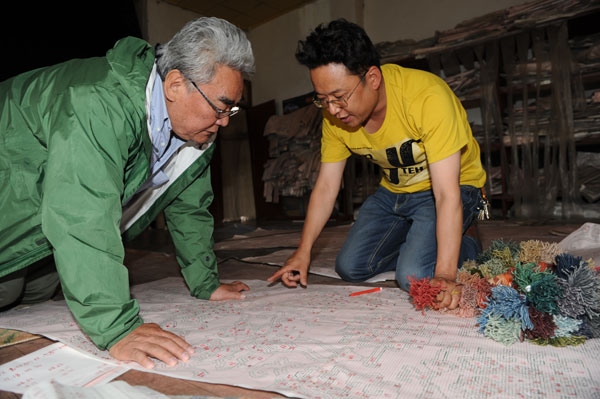Border man with a foot in both camps
As a child in Lhasa 60 years ago, Kesang Tashi watched the goings on at the Datrum, a horse-trading market not far from Barkhor Street, with great interest.
 |
|
Kesang Tashi (left) discusses a new design with a worker at his carpet factory in Lhasa. Photos by Li Zhou / for China Daily |
On a recent visit to the newly renovated market, Tashi, now aged 70 and dressed in a Western suit rather than traditional garb, was asked: Are you a local or a foreigner?
The elderly man was not surprised by the question because the answer could be "both", so he responded by saying he's a Tibetan who lives overseas.
He is from Tibetan stock. To be precise, he is a native of the Kham region, whose inhabitants are known as Khampa.
He was born in 1943 in what was then Gyalthang region, now better known as Shangri-La, where the Tibet autonomous region meets the provinces of Yunnan and Sichuan, close to the border with Myanmar. As a result, Tashi likes to call himself a "man from the border".
At the age of 12, Tashi moved to northern India with his family. Later he moved to the United States, where in 1966 he was offered a scholarship at Dartmouth College in New Hampshire. Following a master's degree at the University of Wisconsin, he became a banker on Wall Street and a US citizen.
"My Tibetan identity has always been strong, but it's changed, of course, and has constantly grown and developed as I have matured," said Tashi.
While studying at a missionary school in India, he was exposed to Christianity, but although the school authorities tried to convert him, he kept his Buddhist faith. However, he "learned a different perspective. The Christians were engaged in building wonderful schools and hospitals and I saw lot of the good things they did."
His perspective widened further during his period of study in the US. It gave him what he calls "an analytical distance" and he began to look at Tibetan culture "without bias and the way it really is". He read Buddhist philosophy during his post-graduate days and found it enormously stimulating.
"After graduation, I felt that since I had been busy learning about my own cultural roots, I had to learn something about US culture too, and asked myself, 'What are the best things?' I really needed to learn about finance. I wanted to get a bird's eye view of it," he said.
For several years, he lived the frenetic life of a banker but, by the 1980s, crunching impressively large numbers was not enough to satisfy him anymore. "I knew Tibet was opening up and there might be an opportunity to do something meaningful there," he recalled.
A trip back to Lhasa in 1986, 32 years after he left the city for India, brought him back to his roots. Since then, he has divided his time between the US and Tibet.
It was also on Barkhor Street that he discovered Tibetan carpets for sale, but was dismayed at the poor quality of the goods on offer.
"It was like being hit on the head with a rock," said Tashi. "Tibet has the best wool in the world for making rugs. But the colors of the rugs on display were awful. So, I decided to revitalize Tibetan rugs through a return to tradition."
The decision to resign from Wall Street didn't take too much time and he began working with Tibetan master weavers and quasi-governmental organizations to produce quality rugs for export to the US market, which at the time was dominated by carpets produced in Nepal.
In 1994, he started a joint venture. The company became famous for its "Khawachen Carpets of Tibet" brand, and over time the business expanded to Europe, Japan, Australia and New Zealand.
For Tashi, the thing that makes Tibetan rugs unique is not just the highland sheep wool, but also the designs, motifs and symbols that go back to the ancient Silk Road era of rich cross-cultural fertilization.
The carpets combine central Asian and primitive Tibetan designs and also incorporate the influence of the Han Chinese.
"When they come together, Tibetans are very good at synthesis, they bring in all those design ideas to make something uniquely Tibetan," said Tashi, sitting in the factory in Lhasa, where he employs 30 weavers.
Weaving is very much like a religion in Tibet, he said.
|
|
|
|
|
|
|
|
